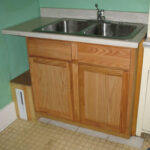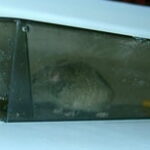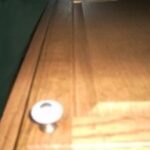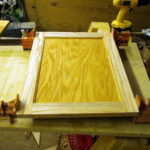Congratulations! You got your wife a new garbage disposal for Christmas. But there’s a problem. She wants you to install it. Something about serving you right, she said. And you have no idea how to go about changing a garbage disposal. Relax. I can help you. It’s easier than you might think.
Clean out the junk from inside the sink cabinet.
Take advantage of the opportunity to get rid of the mousetraps, loose garbage bags, cleaning supplies, etc.
While you’re under there, take a careful look at the drain pipes. If they look corroded or stained, consider changing them at the same time you change out the disposal.
Disconnect the electrical.
Follow the electrical cord from the disposal. If it ends with a plug at a wall outlet, unplug it. If the electrical cord or wire disappears in the wall or is hard wired to an electrical junction box, find the appropriate circuit breaker in the electric panel and turn it off. Be sure to check for the presence of electricity with a multi-meter or electrical tester even after turning off the circuit breaker. Don’t trust the label in the electric panel. There is a chance it might be miss labeled. If the disposal is hard wired wait to disconnect the wiring until after the old disposal is removed from the sink. It is much easier that way. You don’t have to lie on your back and work under the old disposal.
Disconnect the drain pipe.
The drain pipe may be chrome plated brass or cream colored pvc plastic. If it is metal, use a small 12 or 14 inch pipe wrench also called a monkey wrench, water pump pliers, sometimes called channellocks, or slip joint pliers, to undo the slip joint nuts. They can cut your hands. Don’t worry if the corroded metal falls apart or breaks, you’re going to replace it anyway. In most cases you can unscrew the plastic slip nuts with your hands. Sometimes they are corroded in place, as well, and you may need to use a wrench. Be careful not to squeeze the plastic out of round or it will not come unscrewed. Catch the drain water in the p-trap (the u-shaped piece of drain pipe) with a small pail or container.
Remove the old disposal.
There are many kinds of garbage disposals. There are also a number of different ways in which disposals are mounted to sinks. We will talk here about the most common method of attachment. In broad terms, these instructions will apply to all garbage disposals.
At the top of the old disposal you will find three small loops of metal like short sections of tube about half an inch long or so evenly spaced around the circumference of the disposal connector ring. Place the tool that came with the old disposal in one of the loops and pull in a counter clockwise direction. You can also use a screwdriver tip or metal rod of the appropriate size to disconnect the connector ring if you don’t have the old tool. A new one should also have come with your new disposal. The connector ring should rotate about one third of a turn and the disposal will drop down from the bottom of the sink. If it has been there a long time, you may have to wiggle the disposal back and forth to break the corrosion free. Be careful because the old disposal can be kind of heavy. Don’t lie underneath it!
Remove the old disposal strainer.
There are three threaded studs on the bottom side of the strainer holding the old disposal strainer in place. Unscrew all three studs until the lower half (the half underneath the sink) is loose. At the lower end of the strainer there is a snap ring. It is a small diameter ring located around the extreme lower end of the strainer. Pry the snap ring out of its groove with a small screwdriver tip or knife blade. Be careful because it is under a little tension. It can fly off and strike you. Now remove the lower strainer plate and gaskets and push up on the strainer body. It should come free from the sink hole. If it doesn’t, corrosion has welded it in place. Simply wiggle it back and forth until it breaks free. You can use some WD-40 to help free it up if needed. In extreme cases, a little heat may be needed to free it. Now clean up the old putty around the strainer hole. Make sure the sealing edge is smooth and clean before attempting to install the new strainer.
If old disposal was hard wired, now disconnect the electrical connection
Lay the old disposal on its side and find where the wire enters the bottom of the disposal. With a Phillips head screwdriver, unscrew the small screw holding the plate over the electrical box. Pull out the black and white wires from inside the electrical compartment. Unscrew the wire nuts and pull both sets of wires apart. With your screwdriver loosen the green ground screw inside the electrical compartment and remove the ground wire. Now unscrew the Romex connector from the outside of the electrical compartment and pull it and the wire free of the old disposal. If the old disposal was wired with a pigtail cord and plug, follow the above procedure to remove it, as well.
Install the electrical wire or cord and plug.
Reverse the order of electrical disconnection to install the cord and plug or electrical wire in the new disposal. Be sure to use new wire nuts and install the ground wire carefully.
Install the new disposal strainer.
If the new strainer came assembled, take it apart following the strainer instructions above. Knead a small amount of plumbers putty until it is soft and well mixed. Roll it out between your palms into a small diameter rope and place it around the sealing flange of the new strainer. Gently press the putty flat making sure there are no gaps. Place the strainer body in the sink hole. Working from underneath the sink, place the gasket over the strainer body followed by the strainer plate and the threaded stud plate in that order. While holding them in place with one hand, place the snap ring over the end of the strainer body and push it into its groove with the fingers and thumb of the other hand. It helps if you have somebody who can press down on the strainer from inside the sink bow while you work from inside the sink cabinet. The snap ring must snap into its groove positively. Now tighten the three threaded studs evenly against the strainer plate until they are all tight. Remove the excess putty from inside the sink bowl.
For a dishwasher drain, knock out the drain plug in the new disposal.
If you have a dishwasher whose drain line is connected to the disposal, place a screwdriver in the dishwasher drain port on the new disposal and tap it with a small hammer. Retrieve the metal plug from inside the disposal. Be sure you get the plug out or it will jam the new disposal when you turn it on.
Install the new disposal.
Lift the new disposal up into position, and, while holding it there from underneath with one hand, line up the connector ring with the other and turn it clockwise one third turn. Inspect all three locking loops on the connector ring to make sure their lugs have engaged the strainer plate. This is the most difficult part of the entire process, and the most important, so get some help if needed.
Install the new drain elbow.
Place the drain elbow gasket in the disposal drain hole. Place the drain elbow over the gasket, slide the drain elbow plate over the drain elbow and install the drain elbow screw(s). Tighten firmly.
Hook up the new drain pipe to the disposal drain elbow.
Place a new slip nut and gasket over the drain elbow. Install the new pvc p-trap. Tighten the plastic slip nuts by hand at first. Be sure to line up the drain pipe joint before tightening the nut to insure a leak free joint. If you have a dishwasher, place the dishwasher drain hose over the new disposal dishwasher drain port, install a new hose clamp and tighten it. Make sure there are no dips in the dishwasher drain hose.
Test your new installation.
Now turn on the water and check your drain pipe connections. If one or more of them leak, simply tighten the slip nuts a little more. If the connections still leak, loosen the nut and realign the parts. Retighten the nut and run some water down the sink to check it again. Now turn on the electrical at the circuit breaker panel or plug the disposal cord into its wall outlet. Turn on the switch and turn on the water again. Check your work under the sink one more time. Congratulations! You are done.
A word about garbage disposals.
If you have a private sewage disposal system (septic tank) a garbage disposal is generally not a good choice. They contribute solids to your system that will need to be removed from time to time by a septic pumper. It is better to compost in that case. Garbage disposals work well on municipal sewage systems where the sewage is treated.
Ø Treat your new garbage disposal kindly and it will serve you well for a long time.
Ø Don’t feed it fibrous materials like carrots, half a grapefruit rind, or celery.
Ø Finely chop produce before putting it down the disposal.
Ø Always run plenty of water while running the disposal. It helps to flush the material down the drain.
Ø Garbage disposals are designed for use with heavy weight sinks like cast iron. If you mount one in a light weight stainless steel or plastic sink, you may experience leaking problems due to vibration. You can minimize this by chopping up organic materials finely before introducing them in small quantities in the disposal.






